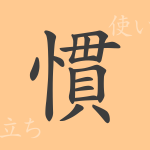Each character has its own history, and the meanings and shapes of each Kanji hide deep stories behind them. The Japanese Kanji “Kan” (管) is no exception. “Kan” is one of the Kanji frequently seen in everyday life, used in various contexts from music to the concept of management. This article delves into the origins, meanings, and usage of the Kanji “Kan,” as well as idioms and phrases in Japanese that utilize it, exploring its allure.
The Origins (Etymology) of Kan
The Kanji “Kan” (管) has ancient origins, its shape representing a bamboo stalk split vertically. In ancient China, bamboo was used for various purposes, such as cylindrical containers and musical instruments. This practical background became the etymology of “Kan,” from which the meaning of controlling something through a tube developed. Additionally, the use of bamboo in musical instruments, which produce sound, led to associations with the concepts of communication and management.
Meanings and Usage of Kan
The Kanji “Kan” (管) primarily means “to have jurisdiction over,” “to manage,” and “to lead.” All these are based on the original concept of control. It is also used in terms related to music, such as “wind instruments,” carrying the nuance of controlling sound. Metaphorically, it can also indicate “within one’s reach” or “under one’s influence.”
Readings, Number of Strokes, and Radical of Kan
The basic information about the Kanji “Kan” (管) is as follows:
- Readings: The Onyomi is “Kan”, and the Kunyomi is “Kuda”.
- Number of Strokes: The Kanji “Kan” (管) has a total of 14 strokes.
- Radical: The radical of this Kanji is “Bamboo,” also known as “Takekanmuri”.
Idioms, Phrases, and Proverbs Using Kan and Their Meanings
There are many idioms, phrases, and proverbs in Japanese that include the Kanji “Kan” (管). Here are some examples with explanations of their meanings:
- Kankatsu (管轄): The range of authority in which an organization or person manages or supervises certain matters.
- En- no- shita -no- chikaramo-chi (縁の下の力持ち): Someone who doesn’t stand out but actually exerts great influence and support. Literally translates from “pipe under the floor.”
- Kanken (管見): The range of one’s knowledge or insight, or an opinion or viewpoint within that range.
- Kuda- wo- ma-ku (管を巻く): The state of skillfully manipulating something. It comes from playing a musical instrument by winding the tubes.
Conclusion on Kan
The Kanji “Kan” (管), as its shape suggests, has long symbolized materials and concepts closely related to people’s lives. While it is used to express power and influence through its image of management and control, it also possesses an artistic aspect, as seen in wind instruments in music. In Japanese idioms and phrases, “Kan” is central to diverse expressions, and its range of use is broad. Thus, the multifaceted Kanji “Kan” (管) can be said to symbolize the richness of the Japanese language.

























